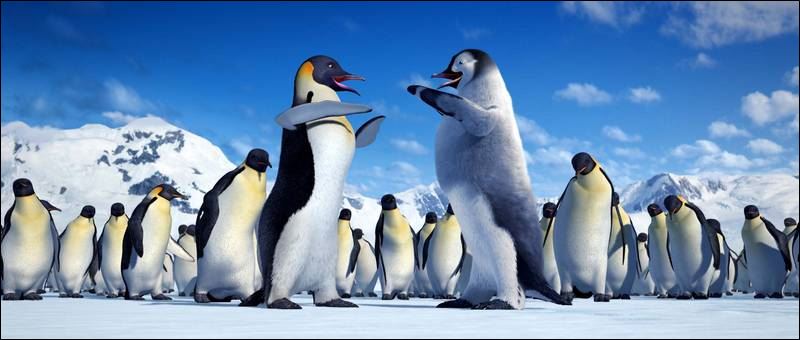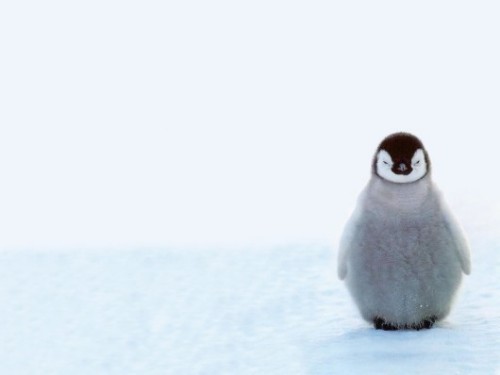
The Warner Bros. Pictures (2006) film Happy Feet tells the heart-warming tale of Mumble (Elijah Wood), a dancing emperor penguin who is a little different from the rest of his kind.[1] Mumble becomes an outcast in his own community because unlike every emperor penguin before him he is unable to sing. His talents lie elsewhere in the form of a groovy style of tap dancing. However, Mumble’s life is not all doom and gloom as his Happy Feet prevail in the end when his dancing saves his colony from the peril of a fish shortage and leads him into the flippers of his alluring love interest Gloria (Brittany Murphy). His dancing attracts the attention of humans that have been responsible for the fish shortage due to overfishing and acts as a warning of the consequences of their actions. The humans pull out of the Antarctic waters and everyone gets their happy ending along with an abundance of fish and Mumble himself gets not only the girl but also acceptance into his community. Mumble and his feathery friends are used to convey two very different messages. On one hand we have the moral message of accepting who we are and celebrating our individuality and then on the other there is the environmental message that expresses concerns about overfishing and climate change.
This uplifting coming-of-age penguin tale falls into the category of the animated family film. For Noel Brown and Bruce Babbington, the family film is made up of ‘a story which, while acknowledging the possibility of an unpleasant or undesirable outcome, is finally upbeat, morally and emotionally straightforward’.[2] This is very much true in the case of Happy Feet as Mumble’s social exile and the lack of fish create the potential for an unhappy ending but Mumble’s perseverance gives the film the happy ending everyone is rooting for. The animation in the film creates the potential of bringing the non-human characters into the realm of the human, making them more relatable for the audience. By making Mumble and the other penguins talk and dance the lines of distinction between real penguins and fictional one are being blurred and what are essentially accepted as human characteristics are being projected on to animals. This allows them to become a vessel for the moral message of the film as when people can relate to them they also learn from them.
The humanisation of animals is also referred to as anthropomorphism. In Happy Feet the penguins are anthropomorphised in several ways from their personalities to their everyday life. For example, Emperor-Land is given an educational system similar to our own. When Mumble is a child he and the other young penguins all attend school where they learn to sing and find their ‘heartsongs’. They even have a graduation ceremony once their time in education is over which mirrors the human celebration of graduating school or university. This education system becomes another tool through which Mumble is ostracised as his inability to carry a soulful tune leaves him at the back of the class and even denied his right to graduate. The heart-breaking image of a downtrodden Mumble watching on as everyone else from his class gets to graduate and have fun serves as a message to the audience of tolerance. The treatment of Mumble seems so unfair to the audience because they can identify with and even recognise themselves in Mumble because the boundary of the human and the animal has been blurred to convey this moral message.
However, there can be problems with anthropomorphising animals in animation and in Happy Feet humanising the penguins to make them more relatable seems to come at the expense of the environmental subplot. Jonathan Burt claims that ‘ethical questions arise most severely at the point at which the line between the fictitious and the real animal is most difficult to draw’ which is what’s happening here.[3] The penultimate scene of the film sees the emperor penguins desperately dance for their lives but it’s not necessarily portrayed that way. Mumble has brought the humans back to Emperor-land with his dancing and he convinces the rest of his colony to join him in dancing for them to stop the fish shortage. The camera shot focuses on Mumble tapping alone at first then slowly pans out to more and more of the penguins joining in until individual penguins become indistinguishable and they are just one huge mass of dancing penguins. The human’s reaction to the dancing is a wide-spread debate about overfishing in the Antarctic which results in them deciding to stop all fishing there. Although the film doesn’t address this, the emperor penguins are being used as sentinel beings which means that they are being used to detect risks to humans by providing advanced warning of danger. Their dancing is the warning and the risk is over-fishing and climate change. However, dancing is a human pastime, not an emperor penguin’s hobby so by having all of them dance in unison so determinedly suggests they have to act less like the animals they are to become valuable to humans. Sarah McFarland and Ryan Hediger claim that we as humans don’t ‘ethically relate to other creatures in ways that allow them to exist as more than simply a mirror of ourselves’ which is how what seems to be happening here.[4] The penguins have to be somewhat humanised in order for us to value them or see them as worth saving which completely undermines the environmental message as it suggests it is up to the penguins to get our attention by acting this way rather than for us to value the lives of the penguins regardless of their behaviour. The film unintentionally suggests that the only way animals can become valuable to humans is if they can do something like us or for us. So in this film the humans save the cute and loving Mumble not because it is the right thing to do but because he has something to offer them.
The film has some potential to achieve its environmental agenda which we see in brief moments such as the visually stunning scenes of the cracking ice or the melting icicles that often appear in the shot yet these things aren’t openly addressed, they have to be sought out. It is as though Miller and Warner Bros. Company are too scared to fully commit to the environmental message so instead give their audience a hesitant and diluted version of it that holds little ground. The film becomes so fixated with the fictional penguin that neglects the real one it is supposed to be representing. In the film’s inspirational happy ending the humans have decided to stop all fishing in the Antarctic seas and all the penguins dance and sing to Stevie Wonder’s chart topper ‘I wish’ whilst throwing fish around like it’s going out of fashion. However, the realism of this situation is that overfishing is not the only threat to their existence. Climate change also plays a big part as the emperor penguins rely entirely on ice for their existence. They are born and bred on the ice and the Krill fish they feed on, feed on types of plankton that grow on the ice so climate change creates a ripple effect throughout the food chain that has potentially catastrophic consequences. So having an ending that shows an abundance of fish, ice and penguins creates an unrealistic and potentially damaging impression about how these environmental issues can be rectified.
Joanie Hilton inadvertently summed up the problem of Happy Feet’s representation of animals when she wrote that ‘after watching ‘Happy Feet’, little Johnny might ask his parents where Mumble is and if they can go and visit him. Unfortunately, one day not too long from now, his parents will have to say that Mumble does not exist anymore’.[5] Whilst the moral message succeeds in teaching a valuable lesson to the audience of acceptance and individuality, it does so at the expense of the environmental message. The penguins are anthropomorphised so that they are more relatable and so they can teach us a moral lesson about our own world but through anthropomorphising them the environmental subplot is undermined. This subplot is supposed to teach us a lesson that concerns the plight of the real emperor penguins but the penguins in the film are not a representation of real emperor penguins and the struggles they truly face are only half-heartedly mentioned in this film. McFarland and Hediger sum up their analysis of Happy Feet with the conclusion that ‘these kinds of pseudo-environmentalist films do little more than make us feel good’ which is something I have to agree with.[6] This film is rich with its moral message, endearing characters and fun musical numbers leaves you with a smile on your face and a warm feeling in your heart but little knowledge about the real emperor penguins it is based on. This is not necessarily a major problem for the film because if all you are looking for in a film is a feel good family orientated story line with an impressive soundtrack then Happy Feet is the one for you. However, if you’re hoping for a film that will engage with the hard-hitting truth about the struggle of the emperor penguin as well as offering you entertainment and fun then you might be best to seek elsewhere. Happy Feet is not alone in this as there are several animal themed animated family films that also have a political or environmental agenda such as Ice Age 2: The Melt Down, Hoot and even Happy Feet Two, the follow up film which follows a similar plot line only this time with the addition of Mumble’s son Eric. Again all these films have admirable and successful moral agendas which in most seems to overshadow any environmental success they may have.
Bibliography
Burt, Johnathan, Animals in Film, (London: Reaktion Books, 2004)
Babington, Bruce and Brown, Noel, Family Films in Global Cinema: The World Beyond Disney, (London, I.B Taurus, 2015)
Happy Feet, Dir. George Miller, Warner Bros. Pictures, (2006)
Hediger, Ryan and McFarland, Sarah, Animals and Agency: An Interdisciplinary Exploration, (USA: BRILL, 2009)
Hilton, Joanie ‘Happy Feet’s Penguins Silenced by Climate Change’, Hobart and William Smith Colleges, (2011) <https://www.hws.edu/academics/biology/images/Hilton2011.pdf> [Accessed 25th November 2015]
Further Reading/Information
‘Happy Feet and Human Ecology: A century of Environmentalism’, Eco-Cinema and Film Genre (2011) <https://ecocinema.blogspot.co.uk/2011/12/happy-feet-and-human-ecology-century-of.html>
Kelly, Kate, ‘New Film ‘Happy Feet’ confronts serious issues’, Wall Street Journal, (2006) <https://www.post-gazette.com/ae/movies/2006/11/17/New-film-Happy-Feet-confronts-serious-issues/stories/200611170209>
March of The Penguins, Dir. Luc Jacquer, Warner Independent Pictures, (2005)
Wells, Paul, Animated Bestiary: Animals, Cartoons and Culture, (London: Rutgers University Press, 2009)
[1]Happy Feet, Dir. George Miller. Warner Bros. Pictures. 2006
[2]Bruce Babington and Noel Brown, Family Films in Global Cinema: The World Beyond Disney, (London, I.B Taurus, 2015) pp. 5
[3] Johnathan Burt, Animals in Film, (London: Reaktion Books, 2004) pp. 12
[4] Ryan Hediger and Sarah McFarland, Animals and Agency: An Interdisciplinary Exploration, (USA: BRILL, 2009) pp. 100
[5] Joanie Hilton, ‘Happy Feet’s Penguins Silenced by Climate Change’, Hobart and William Smith Colleges, (2011) <https://www.hws.edu/academics/biology/images/Hilton2011.pdf> [Accessed 25th November 2015]
[6]Ryan Hediger and Sarah McFarland, Animals and Agency: An Interdisciplinary Exploration, pp. 103

